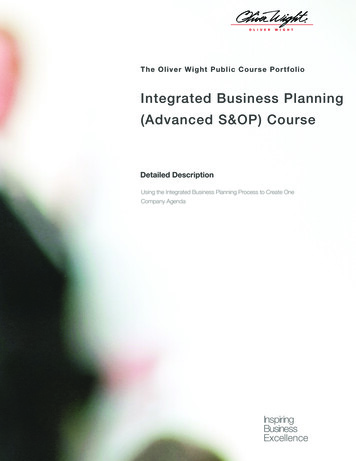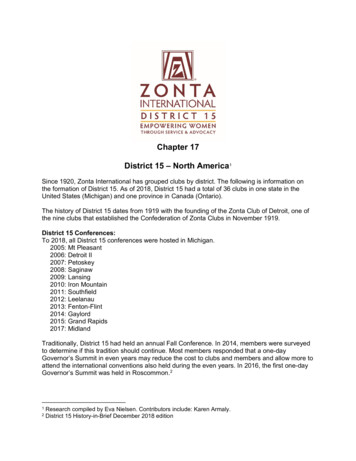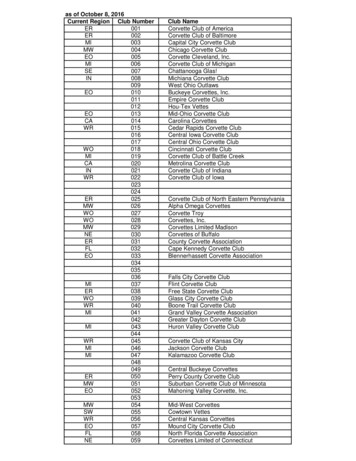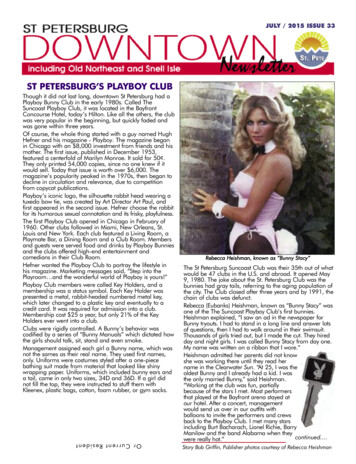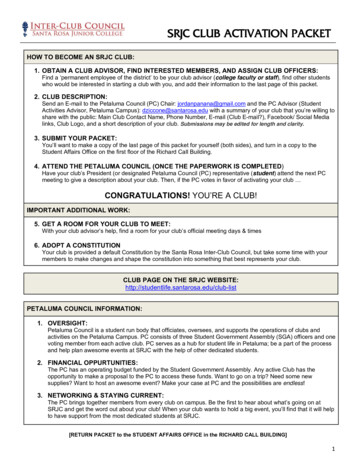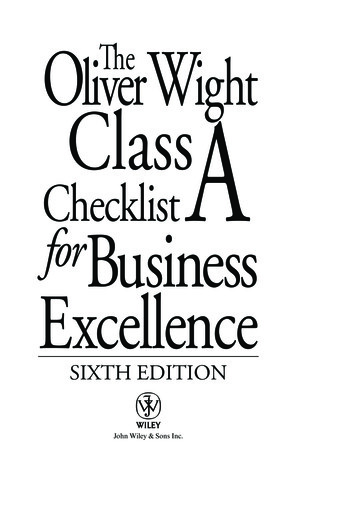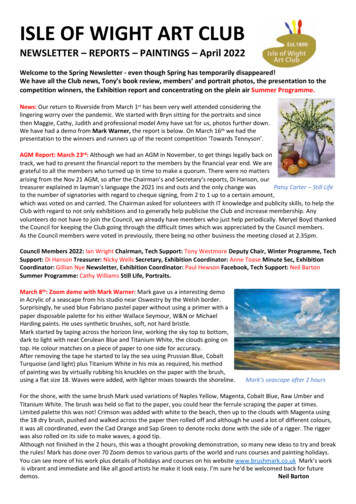
Transcription
ISLE OF WIGHT ART CLUBNEWSLETTER – REPORTS – PAINTINGS – April 2022Welcome to the Spring Newsletter - even though Spring has temporarily disappeared!We have all the Club news, Tony’s book review, members’ and portrait photos, the presentation to thecompetition winners, the Exhibition report and concentrating on the plein air Summer Programme.News: Our return to Riverside from March 1st has been very well attended considering thelingering worry over the pandemic. We started with Bryn sitting for the portraits and sincethen Maggie, Cathy, Judith and professional model Amy have sat for us, photos further down.We have had a demo from Mark Warner, the report is below. On March 16th we had thepresentation to the winners and runners up of the recent competition ‘Towards Tennyson’.AGM Report: March 23rd: Although we had an AGM in November, to get things legally back ontrack, we had to present the financial report to the members by the financial year end. We aregrateful to all the members who turned up in time to make a quorum. There were no mattersarising from the Nov 21 AGM, so after the Chairman’s and Secretary’s reports, Di Hanson, ourtreasurer explained in layman’s language the 2021 ins and outs and the only change wasPatsy Carter – Still Lifeto the number of signatories with regard to cheque signing, from 2 to 1 up to a certain amount,which was voted on and carried. The Chairman asked for volunteers with IT knowledge and publicity skills, to help theClub with regard to not only exhibitions and to generally help publicise the Club and increase membership. Anyvolunteers do not have to join the Council, we already have members who just help periodically. Meryel Boyd thankedthe Council for keeping the Club going through the difficult times which was appreciated by the Council members.As the Council members were voted in previously, there being no other business the meeting closed at 2.35pm.Council Members 2022: Ian Wright Chairman, Tech Support: Tony Westmore Deputy Chair, Winter Programme, TechSupport: Di Hanson Treasurer: Nicky Wells Secretary, Exhibition Coordinator: Anne Toase Minute Sec, ExhibitionCoordinator: Gillian Nye Newsletter, Exhibition Coordinator: Paul Hewson Facebook, Tech Support: Neil BartonSummer Programme: Cathy Williams Still Life, Portraits.March 8th: Zoom demo with Mark Warner: Mark gave us a interesting demoin Acrylic of a seascape from his studio near Oswestry by the Welsh border.Surprisingly, he used blue Fabriano pastel paper without using a primer with apaper disposable palette for his either Wallace Seymour, W&N or MichaelHarding paints. He uses synthetic brushes, soft, not hard bristle.Mark started by taping across the horizon line, working the sky top to bottom,dark to light with neat Cerulean Blue and Titanium White, the clouds going ontop. He colour matches on a piece of paper to one side for accuracy.After removing the tape he started to lay the sea using Prussian Blue, CobaltTurquoise (and light) plus Titanium White in his mix as required, his methodof painting was by virtually rubbing his knuckles on the paper with the brush,using a flat size 18. Waves were added, with lighter mixes towards the shoreline.Mark’s seascape after 2 hoursFor the shore, with the same brush Mark used variations of Naples Yellow, Magenta, Cobalt Blue, Raw Umber andTitanium White. The brush was held so flat to the paper, you could hear the ferrule scraping the paper at times.Limited palette this was not! Crimson was added with white to the beach, then up to the clouds with Magenta usingthe 18 dry brush, pushed and walked across the paper then rolled off and although he used a lot of different colours,it was all coordinated, even the Cad Orange and Sap Green to denote rocks done with the side of a rigger. The riggerwas also rolled on its side to make waves, a good tip.Although not finished in the 2 hours, this was a thought provoking demonstration, so many new ideas to try and breakthe rules! Mark has done over 70 Zoom demos to various parts of the world and runs courses and painting holidays.You can see more of his work plus details of holidays and courses on his website www.brushmark.co.uk Mark’s workis vibrant and immediate and like all good artists he make it look easy. I’m sure he’d be welcomed back for futuredemos.Neil Barton
April 12th – Anne Toase, our Council member and well respected artist on the mainland and the Island, will bedemonstrating an Introduction to Portrait Drawing for Beginners. This will be Zoomed at Riverside and at home, thelink will be emailed to members beforehand as usual. If you feel that you would like to join in the weekly portraitsessions but don’t know where or how to start, Anne will give you the confidence to have a go. You’ve got nothing tolose, it’s only paper!April 19th – Sally Pengelly, another of our talented members will be demonstrating “A Beach Scene” in Acrylic atRiverside and again on Zoom. If you’ve seen and admired Sally’s work, you’ll see how she does it!April 26th – A chance to try out portraiture as Lesley Wellings will be sitting for a half session with hopefully a secondsitter. This will be our last Riverside meeting of the winter before we paint outside, until early October.May 3rd – Summer Programme! Neil Barton has produced an excellent variety of locations to suit all memberswhatever your preference is. From gardens to buses, seas to downs, towns and villages plus a garden party, a painters’picnic and starting with a windmill. On May 3rd we start our programme at Bembridge Windmill. The Windmill whichwas built in the early 1700’s was in use until the early 20th century and for storage in WWll. This National Trustproperty has very recently been given brand new sweeps and looks very smart. You can view the rest of theprogramme online, many thanks Neil, a lot of hard work goes into producing this. And thanks to Paul for making thevideo that accompanies the venues, showing at Riverside and which will remain on the Club’s Facebook page.Not been out ‘plein air’ before?Advice from Ian WrightMaking those first steps to go drawing or painting outside can be a littledaunting if you haven’t tried it before. Where do I start? What can I achieve?Will people start looking over my shoulder!Well, with a little bit of preparation it can be a wonderful way to spend a fewhours outdoors on the Isle of Wight. What is more, you will be in the company oflike-minded people and perhaps visit places that you may not have thought ofgoing to on your own.Much thought has gone into the Summer Programme venues, so you alreadyhave a head start. We try to meet at 10.00-ish, but then you can choose yourown composition and stay as long as you like.Perhaps a few practical tips to think about: Make sure you have all the materials you need for your chosen medium.Virtually anything is possible from just sketching, watercolours, oils etc.Have a chat to find out what others do. However, it’s not easy to go backfor missing items, so plan ahead and pack what you think you need; nottoo much so you can’t carry it, but just enough. Take any provisions/comforts you need. You may be able to buy things locally as well. Take suitable clothing, rain or shine - including any sun hats or suntan cream. Don’t spend all morning choosing your subject, often your first idea is your best, and don’t necessarily choosethe obvious “big view’. It may be too ambitious. When you arrive, have a good look around to pick your composition. You can use proprietary or homemadeframing devices to help you decide what to put in or not. A mobile phone can also help to choose a frame,zooming in or out to choose a composition. A phone will also help to capture the moment, as thelight/tide/clouds/people etc will all change/move while you are there painting! Make yourself comfy, it really helps. Sitting or standing, but not in the sun or wind. Don’t worry about gongoozalers. They probably envy you and will rarely criticise. It’s interesting to talk, butkeep painting. They’ll soon get the idea! Others in the Art Club will be nearby, so you won’t be on your own. Have a go and don’t give up. Drawing or painting is more difficult outside in the elements, but you just mighthave achieved something really original in that morning.IanGongoozalers? ! Me neither, apparently it means ‘a person who enjoys watching activity of others’. It’s use comesfrom people watching activity on canals. EdFollow the Uk Plein Air Artists Facebook group. Put the title into ‘search’ and see what other UK artists produce.
Members’ portraits – lots of Bryns!March 15th at Riverside saw the presentation by our Chairman Ian Wright, of the awards to the winners and runnersup of the recent painting competition of the Tennyson View.Above left: Exhibiting Members winner:Anne ToaseAbove right: Members winner:Cathy WilliamsLeft: Exhibiting Member Runner up:Carol OwenRight: Members Runner up:Andrea Clarkson Price
Favourites from my Bookshelf: Composition of Outdoor Painting by Edgar PayneTony WestmoreIn my earlier days of painting I became familiar with some of the paintings of EdgarPayne, and I was captivated by his magnificent scenes of the mountains of theAmerican west, together with the fishing boats of French Brittany harbours particularlyappealing to me.Edgar Alwyn Payne (1883- 1947) was one of the early American Western painters and aCalifornium Impressionist who worked in a very distinctive style. I did not realise at thisstage why his paintings had so much appeal to me, they were blessed with beautifulcolour harmony, which he mastered by working outside en plein air, but lookingdeeper and closer at his paintings I realised that his compositions formed the mainfoundation of his work, which really shone though in his paintings. Edgar did a lot ofteaching during his life and he collected a great deal of notes and information on artfor teaching, after his death and a little later in life, his daughter subsequently formedthese notes into this wonderful updated version of the book, which published in 1941.This is one of my most loved books, it is a compilation of variousdifferent landscape compositional designs that can be equally appliedto still life work. Just one look at the cover of this book makes you wantto go deeper into it. Studying the arrangement of the cloud layout onthe cover is so pleasing to the eye, both in the shapes and perspectivelayout of the cloud arrangements.It is a book that I find myself continually returning to, re-readingsections for help when I find certain compositions challenging. It isessentially a text book and is full of compositional ideas. It containsmany small black and white thumbnail sketches of compositionaldesigns that Edgar obviously sketched out as information for teachinghis students, together with other designs which are best avoided.Payne was devoted to scenes of rugged beauty, and used animated brushwork, a vibrant palette and shimmering lightof Impressionism in his paintings, whilst many of his contemporaries favoured a quieter more idyllic treatment tolandscapes.He also goes on to analyse work by other successful artists and breaking downtheir compositional designs into more small thumbnail sketches.Later in the book there are various small colour studies and painting example ofPayne’s work, where he studies colour and colour harmony in order to bring outthe best of his composition theory.This book is not cheap, it appears that the estate of Edgar Payne have looked afterhis archive of work and teachings well, and this is to be admired. It is published byDeRu’s Fine Arts California and my edition is a hardback of 170 pages and waspublished in 2005. ISBN 0-939370-11-5. If you are lucky you may pick one up ataround 40, and if you get the chance of a cheaper one – buy it!TonyMembers’ Gallery:Val Cranwell: Acrylic – ‘Up the Creek!’Neil Barton: Oil – Toward the Old Mill, St Helens
Members’ Portraits: A ‘Maggie’ a ‘Cathy’ and 3 ‘Judiths’Exhibition Review: Quarr Abbey – March 31st – April 5thIt is always good to get back to holding Exhibitions again, and after therestrictions of the September exhibition we had the full amount of 3paintings per exhibiting member plus unframed and greetings cards.However, due to rising covid numbers on the Island we decided not to holda preview evening or ‘favourite painting’ vote which we hope will return forthe August exhibition when with the better weather, we can hold a fullpreview evening and make use of the delightful courtyard.The handing in and newcollecting arrangementsworked well and as always we are extremely grateful to the stewardswho without their help we could not run exhibitions.The weather was against us at the start, with rain, hail, sleet and snow!With the cold biting wind it was no wonder the footfall numbers werewell down, only just over 500 for the six days. The sales rose with thetemperature towards the end but presumably with financialuncertainties visitors are being careful. Even the piglets didn’t put in anappearance until towards the end.Although generally numbers were down, the standard of the paintings on display was up! 80 paintings on the wallsand stands, covering oils, acrylics, pastels, watercolour, encaustic wax, silk painting and mixed media. Twentypaintings were sold overall, a diverse mix which was pleasing, plus several hundred cards. We had lots of supercomments from our visitors about the quality of artwork and enquiries about joining the Club which was heartening.Apart from our stewards and Council members who help to run the exhibition, we must thank you, the artists forproducing some amazing artwork once again, and we have to ask you to do the same again for August please. Notlong, so get painting!Nicky Wells – Anne Toase – Gillian Nye – Co Exhibition Coordinators and Di Hanson – TreasurerThere is one photo of each members’ painting from the exhibition on the Club Facebook page – 30 photos.
Members’ Portraits: Amy Murray, a professional model.Queen’s Jubilee Garden Party – Friday 3rd June: Following on with the theme of the Newsletter concentrating on pleinair painting, we have further news on the Garden Party to be held in the beautiful gardens of John and Jose Hunt at59 Station Rd, Wootton PO33 1EH. Parking in the Railway car park or the road – not the gravel road opposite please.The No 9 Ryde – Newport bus stop is right outside.Also for the Garden Party, Chris Archer has donated 50 as new art books from her late husband Neil who was one ofour members. They are about watercolour and sketching, which was Neil’s forte. Each book will be sold by donation,the money going to the very worthy charity, The Wight Brainy Bunch, so being your cash with you as well as cake!Finally for plein air – Urban Sketching:by Gillian NyeUrban Sketching is now a world wide phenomenon! It justmeans keeping a ‘visual diary’ of everyday things, most notablytown, city and village centres and buildings, but includes peopleor animals rather than landscapes. The main thing is that it’sdone on location, en plein air with minimal equipment.No rules, but a few things to help clear your thinking. Work in amedium you know, pencil – mechanical to save sharpening charcoal, pens, something you’re happy with. As you look foryour composition to sketch, find something you think you’llenjoy, don’t sketch something for the sake of it just becauseothers are doing it. Find what pleases you, your sketch will be allthe better for it.Don’t draw an exact representation, we’ve got photos for that, but try to develop your own style. Knowing it doesn’thave to be perfect will make your work looser as you’re not trying to make a copy. Try to get the ‘feel’ of what isaround into your sketch, noise, weather, bustling people or maybe they’re sitting relaxing in a café on a pavement inthe sunshine. You’re trying to capture a moment in time, no one can say it’s not right, as the moment is gone.Move about, if the sketch isn’t working or you don’t want to overwork it or you wish to finish it at home, findsomewhere else. If you can stand with just a small sketch book with good quality paper, a pen or pencil, fine, but ifyou need to sit, try and keep out of the way of passers by. Put your chair with your back against a wall and thegongoozalers (see Ian’s article) won’t be able to look over your shoulder. It’s ok to take a photo if you wish to checkcolours or shadows to put a watercolour wash on later at home. The more you do, you will find your observationalskills will improve, you’re actually looking and noticing and your drawing skill and confidence will improve also.
Some artists try to do a sketch a day, of a plate of food, their cat or dog, a chair or anything that probably wouldn’tmake a painting but it increases your awareness of everyday objects and really does make you look at things moreclosely. It doesn’t have to be a work of art, no one has to see it. It is surprising how unobservant one can be, when Istarted at uni, one of our first exercises was to draw a bicycle, sight unseen. There were some dreadful contraptionsdrawn, try it, it really makes you think!Urban Sketching teaches you proportion and perspective by direct observation, telling a story of your surroundingsand a record of a time and place on a given day. If you’re on holiday with time to spend, keep a visual sketching diaryand add some writing to your work, you’ll find it more rewarding that a hundred phone photos, save that for thestupendous views!The sketch above of Newport is by Tony Westmore. Tony isn’t brilliant by chance, he constantly sketches everyday lifeand has dozens of sketch books to prove it!There are plenty of opportunities in the Summer Programme to try out a different style of sketching, remember itdoesn’t have to be an outline drawing painted it, your sketch will be a piece of artwork in its own right or just amemento of the day. Apart from Urban Sketching in Cowes in June and Old Portsmouth in September, take a lookthrough the programme, a lot of the other venues give the chance to sketch buildings, boats, buses too.If you feel brave enough, go out on your own or with a mate and find some wonderful buildings around the Island.When I was young and walking down Union Street in Ryde, my Dad used to say ‘Look up!” at the architecture of theold buildings, which really are magnificent, of course I looked in the shops, but you can sit outside in cafés in any ofour towns and sketch the buildings above and the life happening below. Have a go at Urban Sketching and send in thephotos of your work to the Editor at gilliannye@rocketmail.comGillianThere is worldwide interest in Urban Sketching, try www.urbansketchers.org where sketchers from all round theworld meet and share their work. You can see examples online plus YouTube, Instagram and Facebook. There are alsobooks to get you started, courses to go on, but you really only need a pencil, a sketchbook and a bit of imagination.Our first two plein air weeks:Bembridge Windmill – May 3rd – with its newsweeps.Bembridge Harbour next to Brading Haven YachtClub – May 10thPlease send any photos of your paintings or anything you think might be of interest to othermembers to gilliannye@rocketmail.comThank you
Favourites from my Bookshelf: Composition of Outdoor Painting by Edgar Payne Tony Westmore In my earlier days of painting I became familiar with some of the paintings of Edgar . Edgar Alwyn Payne (1883- 1947) was one of the early American Western painters and a Californium Impressionist who worked in a very distinctive style. I did not .
